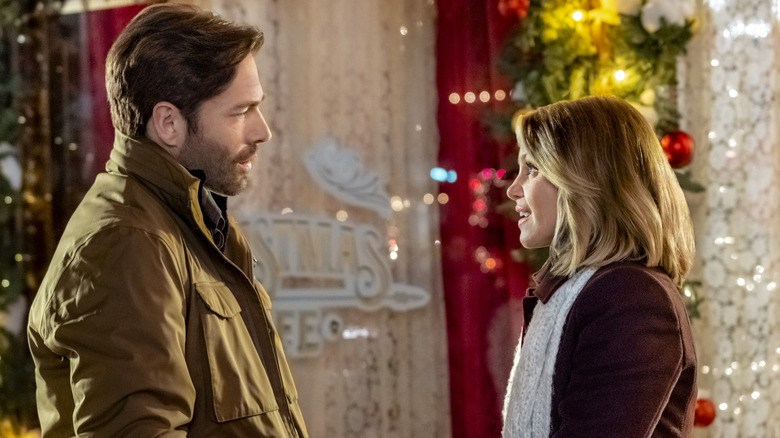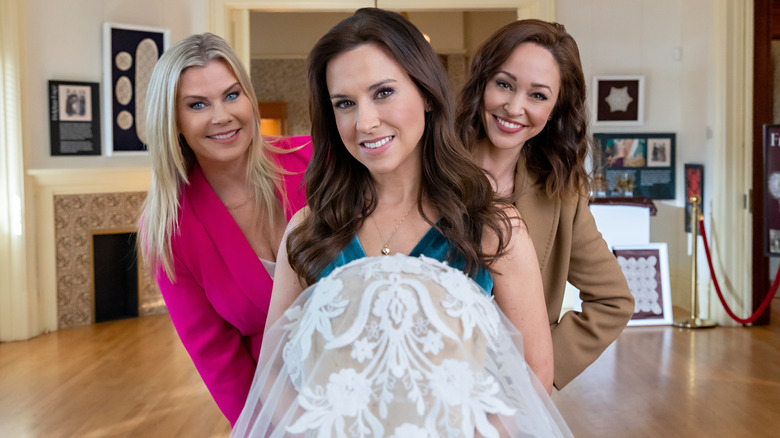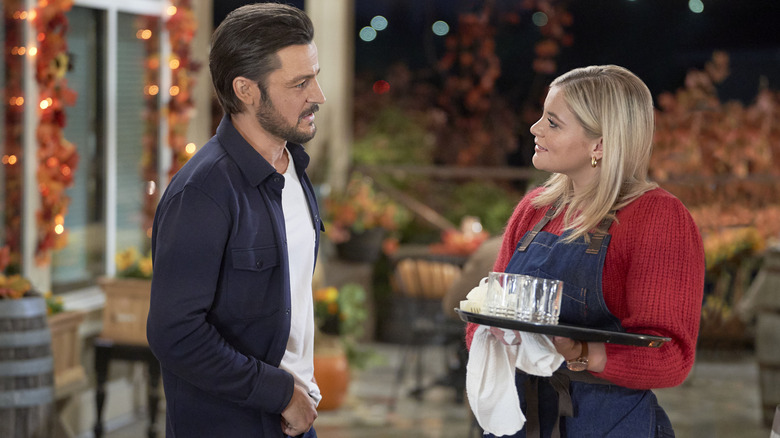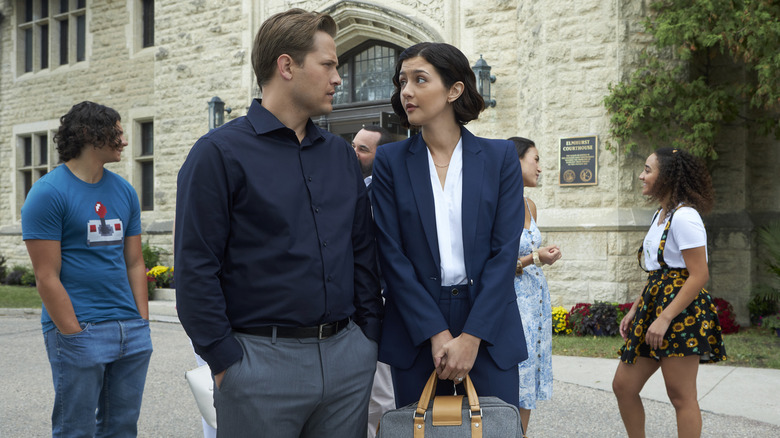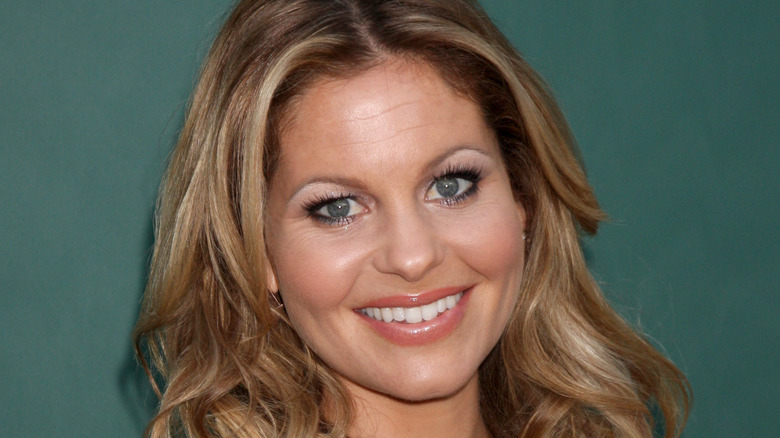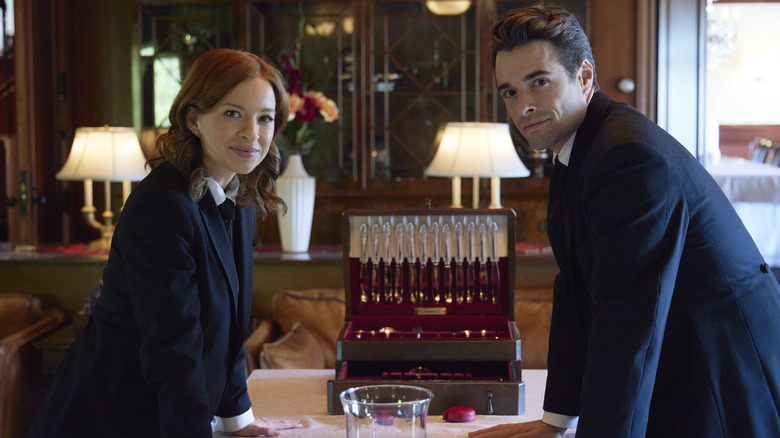Red Flags Everyone Ignores In Hallmark Movies
There's no denying that a lot of people love Hallmark movies — they're cheerful, corny, and predictable in a way that often feels comforting. Clinical psychologist Dr. Cree Scott told North State Journal that watching Hallmark movies can actually be good for your mental health.
"Hallmark movies are all about love, empathy, compassion, and kindness," Dr. Scott said. "When you watch an uplifting movie, especially when they include acts of kindness, it releases cortisol — the stress hormone — in the brain, followed by dopamine, which produces feelings of pleasure."
While it may be true that feel-good movies lead to mood boosts, it's impossible to deny that there are some glaring issues with Hallmark movies, from the generic scripts to an overall lack of diversity. And for those of us who aren't huge Hallmark fans, sometimes it feels like everyone else is just getting their corny holiday fix while willfully ignoring the fact that Hallmark movies can be bad in several different ways. But don't worry, Hallmark haters, your time has come. We're here to run down the biggest red flags everyone ignores in Hallmark movies.
The fact that the plot is always the same
When you settle in to watch a new movie, part of the excitement is that you don't know exactly what's going to happen. You get to watch a story unfold, and it's fun to see the twists and turns. Except when you're watching a Hallmark movie, that is; there are rarely plot twists, and before you even start the movie, you generally know what you're getting yourself into.
Typically, Hallmark movies go a little something like this. An uptight female protagonist from a big city has to go to a small town for work or family. While she's there, she learns how to loosen up a bit (usually while doing tons of seasonally appropriate activities) and just so happens to meet a love interest whom she immediately clicks with. As a cherry on top, the two get married by the end (although, as far as we can tell, they have never so much as kissed).
And, yes, that's part of the Hallmark deal. You know what you're getting yourself into — a charming, simple story with a happy ending. But sometimes these predictable plots end up feeling like a waste of time. After all, who wants to spend two hours watching a movie that feels like déjà vu?
The lack of diversity
Predictable plots and constant positivity may be annoying, but it's not necessarily that big a deal. What is a major red flag about Hallmark is the lack of diversity in its movies and TV shows. Anyone who has seen a few Hallmark movies will likely report that the cast was very white. Actor Fanta Sesay told Daily Hive, "In terms of Hallmark, that is a very open secret in the industry, that they do not cast people of color, and if they do, it's incredibly rare, or it'll be like a best friend role."
The network has also failed to feature LGBTQ+ characters until recently. "They will say they don't have a policy against interracial couples or queer couples ... but the visual is very clear if you look at their programming, if you look at their social media," casting agent Yogi Omar told Daily Hive.
When Hallmark keeps its movies straight and white, it drives home the idea that this is what a "normal" family or relationship looks like. Not only does this alienate viewers who don't fit that mold, but it's also not representative of the world. For a company that aims to appeal to a large audience, it feels like Hallmark is targeting a very small demographic. Perhaps this will change for the better with new CEO Wonya Lucas, who told CNBC she plans to bring more inclusive and diverse content to Hallmark.
The ridiculous Hallmark scripts
The scripts of Hallmark movies often feel forced and unrealistic, with characters delivering stale, out-of-place lines that feel more formulaic than genuine — and that's because they are. Hallmark movies follow a specific format, according to two anonymous Hallmark writers who shared some industry secrets with Entertainment Weekly.
One writer said, "They have a really rigid nine-act structure that makes writing them a lot of fun because it's almost like an exercise. You know where you have to get to: People have to be kissing for the first time, probably in some sort of a Christmas setting, probably with snow falling from the sky, probably with a small crowd watching. You have to start with two people who, for whatever reason, don't like each other and you're just maneuvering through those nine acts to get them to that kiss in the snow."
And according to Hallmark screenwriter Karen Schaler, things like drugs, drinking, nudity, cheating, divorce, swearing, and fighting are heavily discouraged if not banned from scripts altogether. "It has to feel good, it has to be uplifting, it has to take you to a magical place, it has to make you feel safe," Schaler told Bustle. If you say so!
The reliance on cliches
Similar to the way Hallmark scripts seem to follow some very rigid rules, the characters and plots are also pretty predictable. The most glaring example is how the lead protagonist — who is always female — often ends up finding peace and happiness in life only after abandoning her big-city career and finding love with some small-town man.
It's 2023. Why is Hallmark still suggesting that a busy, working woman's path to happiness is finding a husband and becoming a stay-at-home wife or mother? Maybe Hallmark thinks they've found a plot that works, and have decided to stick with it, but this brings up some red flags when it comes to their representation of women.
"The woman basically has to be a saint, but she still has to be a take-charge kind of female until she basically submits to the guy at the end," one anonymous Hallmark writer told Entertainment Weekly.
Seasonal overload
One of the ... hallmarks ... of Hallmark movies is how they really lean into the theme of the movie, whether it's Christmas or a wedding. But are 12 different Christmas activities necessary for a single holiday movie? And have you ever watched a Hallmark Christmas movie where there wasn't snowy scenery at the forefront? It's almost like Hallmark is afraid that if it doesn't have one seasonal element per scene, people will forget what kind of movie they're watching.
We're not trying to be a Scrooge, here — it's just that a little subtlety could go a long way. Imagine a Hallmark Christmas movie that is, yes, set in a snowy small town, but that doesn't focus more on the scenery than the storyline. Imagine the Christmas activities as an ambient background element to the movie, rather than one of the main talking points.
Sure, the seasonal activities set the mood, in a way, but there has to be a limit. There are only so many times that one can watch ice skating and cookie decorating and almost kissing under the mistletoe before it all starts to feel like a Christmas-themed nightmare.
Hallmark movies are made in just two weeks
Have you ever wondered how Hallmark manages to make so many holiday movies each season? Well, it's because their movies are generally shot in 15 days or less. If you're thinking, "Hmm, it seems like it would be hard to produce a high-quality movie in two weeks." Well, we're thinking the same thing. And while the start-to-finish process of pitching the movie all the way to delivering it takes more like three months — still an incredibly short timeline — the entirety of filming is condensed into two weeks. Why are these movies made so fast? More movies equal more money.
Additionally, all that classic snowy scenery that is always part of Hallmark's Christmas movies? It's 100% fake. Not only are all your favorite Hallmark Christmas movies filmed in the summer (so they're ready to be released come winter), but there's also a very small chance that the snow you see is real.
"Snow is expensive. Only once per movie will you actually see it snowing," a Hallmark producer, Britney, told Vancouver Magazine. Sometimes, the snow you see on screen isn't even fake snow. "Usually they just use a soft-focus lens so you don't notice it's just white blankets on the grass."
The dramatic background music
Most people who are familiar with Hallmark movies know that the scores are never too impressive. At best, the music adds a bit of poignancy to dramatic moments. At worst, it's so loud it drowns out the dialogue completely. This is such a common problem with Hallmark movies that an IMDb reviewer, bookandcandle, has actually taken to writing infamous reviews discussing the issue (per Daily Dot).
In one review for "Matchmaker Santa," the reviewer wrote on IMDb, "I noticed that the music in the background was louder than the speaking voices. ... It is as if a record is playing the same music for two hours over and over with high and low notes. There should be no music when the actors speak, unless it is for an endearing apex moment. The music in the background was continuous throughout the entire movie, ruining the movie for me."
Hallmark has addressed the issue by saying the background music may sound louder than normal at times due to the sound mixing, but that doesn't change the fact that their background music is drowning out characters' dialogue.
The attempts to appeal to as many people as possible
It makes sense that Hallmark wants a lot of people to like its movies, but it seems like it would be hard to create a genuine, interesting story when the overarching goal is to appeal to as broad a range of viewers as possible. And when it comes to Hallmark, this desire to appeal to as many people as possible — which really means as many white, cisgender, straight, and maybe religious people as possible — results in its movies being generic and squeaky clean, completely scrubbed of any grit.
Though this strategy seems counterintuitive since it results in movies that all have the same bland flavor, it is, after all, what Hallmark viewers have come to know and love.
"The reason they all look and sound the same is because the network is involved, and they know their main audience is Midwest Christians," anonymous Hallmark producer Britney told Vancouver Magazine. "Netflix did 'Let It Snow' this year. It's interracial, LGBTQ, beautifully shot ... and a prime example of a Hallmark-style movie that would never make it onto Hallmark."
Some of Hallmark's actors
Candace Cameron Bure has come a long way since "Full House." The versatile actor has become a Hallmark darling, starring in dozens of the network's movies in recent years. However, Bure has stirred up a bit of controversy as well — as a conservative Republican in Hollywood, some of her takes have not been received well. One that stands out is when, in 2015, Bure defended a bakery that refused to sell a cake to a lesbian couple for their wedding. On "The View," she said, "I don't think this is discrimination at all. This is about freedom of association. It's about constitutional rights. It's about First Amendment rights. We do have the right to still choose who we associate with."
While Bure is certainly entitled to her opinion, it does come across as condoning anti-LBGTQ+ discrimination. Queer dancer JoJo Siwa told People, "You not liking gay marriage, do your thing, girl. You being religious, do your thing, girl. Of course, I would want everybody to do what they want to do. But to purposely exclude someone because of who they love, that's sh*tty."
Bure isn't the only popular Hallmark actor who has caught up in negative public attention in recent years. Lori Loughlin — another "Full House" alum, coincidentally — was implicated in the 2019 college admissions scandal in which she and her husband were accused of paying bribes to get their daughters into their desired school.
The utter lack of chemistry between Hallmark characters
Most Hallmark movies have a love story at the center. A very prim and PG love story where the characters only kiss once — maybe twice — but a love story, nonetheless. But just because Hallmark features love stories doesn't mean the love stories are believable; in fact, most of the time, the chemistry is severely lacking. Take 2022's "Butlers in Love." Let's bypass the ridiculous storyline for now, which is literally about aspiring butlers, and instead take a look at an IMDb reviewer's experience watching the movie.
"It was an interesting concept," the reviewer wrote on IMDb, "however, there was zero chemistry between the two leads, the interaction amongst the cast was dull, and really the characters were annoying."
"Butlers in Love" has several reviews that note the lack of believable chemistry between the leads, and a lack of chemistry is a very common thread in Hallmark movies overall. It all goes back to Hallmark's obsession with keeping everything squeaky clean in the hopes of appealing to viewers. Chemistry can require a bit of tension and a bit of initial disagreement before characters learn to click and really mesh romantically. However, Hallmark tends to avoid any real conflict, instead relying on the super unrealistic trope that two characters meet and happen to immediately fall in love, with no real bumps along the way.
The fact everything always works out in the end
We have a love/hate relationship with Hallmark's insistence on giving every movie a happy ending. On one hand, that's what you come to watch Hallmark for — a comforting and ultimately inoffensive movie. On the other hand, it makes for a very predictable and boring viewing experience when every aspect of the plot ends tied up in a little bow, with no uncertainty or problems to speak of by the time the credits roll.
Maybe some look to movies for an escape from real life, but we would argue that Hallmark movies veer too far into the realm of unreality with the endings of their movies. A fact of life is that things don't always work out — but that doesn't always have to be a bad thing. Growth and learning don't come from everything magically working out for us. Evolution comes from persevering through hard times. While Hallmark may think that sort of content isn't uplifting or comforting enough, it is much more relatable than sappy, predictable happy endings. And since the network is so focused on drawing in viewers, offering more relatable content may be just what it needs.
